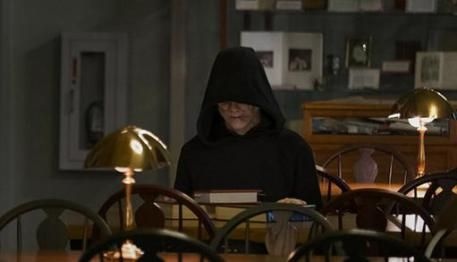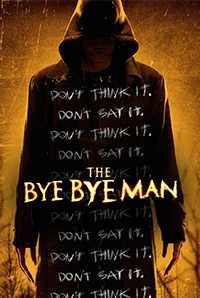
Image courtesy of STX Entertainment
Some interesting statistics about director Stacy Title: she is the youngest woman ever to have been nominated for an Oscar for best live action short (Down on the Waterfront, 1993). Her films are regularly written with or by her husband, Jonathan Penner, who also frequently acts in them. Her first movie, The Last Supper (1995) was a black comedy about liberals becoming as extreme as the right wing bigots they despise. In spite of a cast that included Cameron Diaz and Ron Perlman, it only made less than half-a-million at the box office - but neither Diaz nor Perlman had above the title status at the time. Her follow-up, Let the Devil Wear Black (1999) was a loose re-working of William Shakespeare’s timeless tragedy, Hamlet. Penner was cast as the Prince of Denmark, well, a graduate student. Mother was played by Jacqueline Bisset. The few reviews of this on the website ‘Rotten Tomatoes’ don’t bear repeating; the kindest one says ‘I’ll watch anything with Mary-Louise Parker’.
Title’s follow-up was the 2006 anthology film Snoop Dogg’s Hood of Horror starring Mr Dogg as the Hound of Hell. The best known non-musical cast members include Ernie Hudson, Danny Trejo and Jason Alexander. You don’t want to know about the reviews on ‘Rotten Tomatoes’.
Is there a pattern to Ms Title’s career? She might take on projects that other directors walk away from.
This brings us to Title’s long-awaited fourth film, The Bye Bye Man. It is, to quote Shakespeare, a hit, a palpable hit, grossing $13.3 million at the US box office in its opening weekend from a $7.4 million budget. Even the Snoop will be impressed by that. It even features an Oscar winner, Faye Dunaway, in a supporting role. Don’t get carried away, Dunaway also acted in Michael Winner’s soft-porn remake of The Wicked Lady (1983), a point at which standards went out of the window. Its other well-known star, Carrie-Anne Moss, carries (pun intended) her Matrix dominatrix persona with her as a cop. The junior cast is eclectic. It features British model turned actress Cressida Bonas as the female lead, Sasha, alongside Canadian actor Douglas Smith (US TV’s Big Love) as Elliot and Lucien Laviscount (British TV’s Coronation Street, also RZA’s new film Coco) as John.
It is strange that two out of three of the principal American characters are played by Brits. I have a theory about this: Title, who hasn’t directed a film for ten years, probably didn’t want cast members who challenged her methods. If you put two Brits in the mix, two proverbial fishes out of water, Title won’t seem like the only one.
I have another, slightly more convincing, theory: that Title want to do something with the bogeyman stalker film.
The Bye Bye Man is based on ‘The Bridge to Body Island’, a chapter in Robert Damon Schneck’s collection of ‘strange but true’ stories, The President’s Vampire and other stories. I am not as familiar with modern horror films but this reminded me an awful lot of Candyman. In that film, if you are random enough to say his name five times in front of a mirror, he will appear behind you, point out that you’ve missed a bit, and slaughter you with a hook. At which point, Candyman will find himself standing in a toilet and note that the seat is up. ‘Gosh, darn it, you try pulling the seat down with a hook. Damn that toilet etiquette, I’m going to crack me a lobster.’
You only have to say The Bye Bye Man’s name once and he’ll come for you with a pointy finger and make you see things that will make you commit unspeakable, but nevertheless, PG-13 rated scenes of violence. Like many bogeymen, he is dressed in a cowl, so he won’t be mistaken for a traffic cop or a slightly taller version of E.T. in a monk’s outfit.
The film is about the danger of spreading The Bye Bye Man’s name. People will kill to stop others discovering it, though if you type it into a search engine (as happens here) and someone looks at your search history (as doesn’t happen here, but it should), well, that’s all right then.
There are no marks for originality. But here is the thing that accounts for the success of even the poorest quality horror film. You have to imagine that they might show you some unspeakable scary stuff. Tension can be achieved by turning up the sound really loudly, for example when a train is heading towards you. (This explains why my son always turned his head away when I tried to feed him as a baby – ‘the train is coming to the tunnel’. ‘No, dad, nooooo!’)
It begins with an extended single take opening that takes place on October 20, 1969, an otherwise unremarkable day according to On This Day dotcom. Larry, a deranged man (Leigh Whannell) with horn-rimmed glasses, clearly inspired by both Michael Douglas in Falling Down and the horn-rimmed man from TV’s Heroes, asks a woman ‘who did she tell?’ He then goes back to his car, pulls out a shotgun and shoots through the door. Why did the psycho have to be called Larry? Then some more innocents are shot, as he asks the same question. Finally, we are introduced to three college students who move into a big old house. How many horror films begin with characters moving into a house? It is a lot. (The Amityville Horror, The Conjuring – I know there are others.) In the ‘old house’ narrative, characters make unusual discoveries before really strange stuff starts happening. The major difference with The Bye Bye Man is that the principal viewpoint character is a guy.
Why is this radical for a horror film? Because the viewpoint character in horror films is usually a woman vulnerable to attack. They are ones we fear for, who seem ill-equipped to deal with the horrible stuff. Here, it is a guy. This is not a film in which we hear female screams a heck of a lot.
This is Title’s principal contribution to the horror genre, not a wholesale refresh of the conventions, rather a subtle tweak in order to take away the pleasure of having one’s preconceptions re-confirmed, that women scare easily. It helps that Douglas Smith is not a macho guy. He resembles the late Anton Yelchin or Elijah Wood, puppy fat in the face, wide eyes – the ring, my precious.
Of course, the other pleasure that is missing is the powerful female figure kicking the demon’s ass. But you can’t have everything.
The first discovery is that the furniture in this big ol’ house is in the basement. Then that the room has a large ol’ silver penny in it, you know, the sort they put over the eyes of corpses when bodies are ferried across the River Styx (or the M4) on the way to the Underworld (or Winnersh Triangle). The coins were intended as payment for the Ferryman, but then Hades took those pennies as taxes, so the Ferryman got stiffed. He was waiting for a lord to make the Underworld great again. I wonder how long he’ll have to wait. This silver penny falls out of a drawer in the dresser, the inside of which is covered with graffiti (‘don’t say it, don’t think it’). This is the third component of a successful horror film: the prohibition. This reflects the ‘prohibition’ of the horror film itself for its young and impressionable audience. Everyone knows that when you tell young people not to do stuff, they do it anyway: smoke, take drugs, vote Republican.
It is typically the viewpoint character who discovers the weird stuff. So it happens to Elliot. He then becomes the unreliable relater of seriously messed up stuff. He thinks the dressing gown on a hook is a spectre – and indeed it is.

One thing I haven’t pointed out is that the film is set in the late 1990s – the last time Title directed her own project. We see some very old mobile phones that date back to the turn of the Millennium. Quite apart to the throwback to 1970s and 1980s horror (with a synth soundtrack) there is a very practical movie for setting a horror film in the recent-ish past: promotional consideration. You set a film today and suddenly you have to fill it with brands that your audience knows, not to mention social media. These brands cost money and their use requires approval. Set the film just outside the life experience of your target audience and you can fake products. So ‘google’ is known as ‘search’. Budding horror directors should take this to heart.
Elliot has a brother who is married with a young daughter and envies Elliot’s lifestyle. ‘I never had this,’ he confides in Elliot. ‘I envy what you have,’ Elliot replies. We learn later that their mother had died whilst they were growing up.
Why would a couple invite a single guy to join them in their big ol’ house? Because he’s black! You sense that Title is still on the groove of looking how ‘enlightened’ characters validate their own racial attitudes. John is Elliot’s best friend. Together they are Tier 1. I don’t know what this means in an American context, but in the UK it is synonymous with ‘Highly Skilled Migrants’. Tier 1 could be the name of a band they are yet to start, for want of a bass player. At any rate, you feel Elliot makes John his best friend to prove a point. Why is John Elliot’s best friend? You can’t figure it out.
If Let the Devil Wear Black was Title’s riff on Hamlet, The Bye Bye Man digs on Othello. Elliot is made to get jealous of Sasha spending time with John, especially as visions are put into his head. Sasha does a little investigating – she goes to visit the landlord, who gives her the address of Larry’s widow (Dunaway). Before then there is the small matter of a séance.
In horror films involving the supernatural, there is always an attempt to make contact, ostensibly to find answers. If the characters watched horror films, they will know that malevolent spirits don’t give answers without extracting some sort of pain first. The medium digs on John and they get it together - interracial sex takes place off screen - but then neither John nor the medium can climax. Cue the ‘it’s never happened to me before’ conversation that is really a blame game.
There is a risible scene involving a records keeper who seems to have strayed from the cast of Hood of Horror (she is the only other black character). She leaves Elliot in charge of original documents for five minutes and then he goes full scribble. There is a modest body count and some CGI fire. At one point, the biggest tension is whether Elliot’s young niece can hold her bladder.
The estimable Doug Jones plays The Bye Bye Man. He is like a remote control in human form. He doesn’t have any lines. I’m not sure if it is a union thing. Jones has done memorable work in films such as Pan’s Labyrinth but here he (literally) sleepwalks through it. I kept expecting him to be unmasked by Fred, Wilma, Daphne, Shaggy and Scooby Doo.
The ‘word’ not being spread is an interesting idea, treating a name as a disease. There is an unnameable sacred figure in at least one religion; at a considerable stretch, the film explores religious panic. The name is also akin to a virus, or the videotape in The Ring; it should not be spread or shared at all costs.
The final scene teases a sequel. But The Bye Bye Man doesn’t have the cache of a film series like Friday the 13th, Hallowe’en or A Nightmare on Elm Street. Title doesn’t go for graphically explicit horror. Some scenes are toned down. The effect is a horror film with the mute button switched on. Although the film trades on urban myth, it does not become one.

Reviewed at Cineworld O2, North Greenwich, Screen One, Thursday 19 January 2017, 19:00 screening



